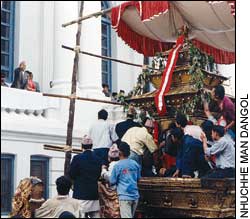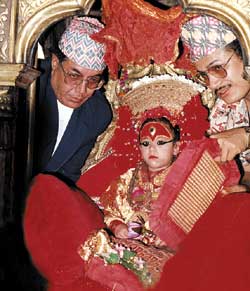 This Friday is the beginning of the weeklong festival Indra Jatra, the annual Newari carnival when the king of Nepal comes officially to pay his respects to the living goddess.
This Friday is the beginning of the weeklong festival Indra Jatra, the annual Newari carnival when the king of Nepal comes officially to pay his respects to the living goddess. The Kumari will be dressed in resplendent red and gold, bedecked in a golden tiara and Sesh Naag around her neck as she rides her rath. On her forehead is painted a vermilion third eye on a black backdrop of mustard oil and soot-this is the mythical divine eye which sees everything. She can see through every individual's mind, and fathom things beyond a common person's understanding.

When she rides the main chariot, she will be followed by two of her friendly deities, Bhairab and Ganesh who are also chosen and made god the same way as the Kumari herself. But these incarnates have it slightly easier, they can stay in their parent's house. They can go out, and play but the Kumari can't. On Friday, the three will tour the city in their chariots and the streets come alive with the mask lakhe dance, music, and feasting. Indra Jatra lasts a whole week, and it will be a whirlwind time for the Kumari as she takes part in the rituals and drums and dancing every day from the setting up of the Indradwaja pole at Basantapur on Thursday.
This is the annual festival dedicated to Indra, the god of rain. But it is also dedicated to Taleju Bhawani, the powerful goddess and protector of Kathmandu who will manifest herself in the Kumari to empower the king and his citizens with divine power. Interestingly, Taleju is supposed to be the family deity of Ravana, the demon king of mythic Lanka and the Taleju of Kathmandu is said to have been brought from India in ancient times.
King Gyanendra, accompanied by invited dignitaries, high officials and diplomats will observe the commencement of the Kumari Rath Yatra from the balcony of the Rana Victorian-style stucco Gaddi Baithak.
 On Saturday, after the King and queen flag off the rath yatra from the Gaddi Baithak the three chariots take an ancient route which on the first day will go to the southern part of Kathmandu, the "tallo tol"-Chikamugal, Gofala Tol, Bharma Tol, Hyumat, Jaisi Degal, Kohiti, Bhimsenthan. On the full moon day Sunday, the 'mathillo tol' people will get to see the chariot being pulled north through Pyafal, Yethka, Nardevi, Raktakali, Pyangal, Nyokha, Bangemuda, Ason, Balkumari, Macchendra baha, Indrachowk, Makhhan and back. The chariot pullers, and other revellers when they arrive near the Akash Bhairab statue near Hanuman Dhoka drink the Newari holy liquor streaming from the deity's mouth with a belief that it will wash away all sins. The thhon flows freely, there is feasting and general merriment.
On Saturday, after the King and queen flag off the rath yatra from the Gaddi Baithak the three chariots take an ancient route which on the first day will go to the southern part of Kathmandu, the "tallo tol"-Chikamugal, Gofala Tol, Bharma Tol, Hyumat, Jaisi Degal, Kohiti, Bhimsenthan. On the full moon day Sunday, the 'mathillo tol' people will get to see the chariot being pulled north through Pyafal, Yethka, Nardevi, Raktakali, Pyangal, Nyokha, Bangemuda, Ason, Balkumari, Macchendra baha, Indrachowk, Makhhan and back. The chariot pullers, and other revellers when they arrive near the Akash Bhairab statue near Hanuman Dhoka drink the Newari holy liquor streaming from the deity's mouth with a belief that it will wash away all sins. The thhon flows freely, there is feasting and general merriment. The next day there is the brief Nanichya Rath Yatra when the Kumari chariot is taken up to Nardevi and turns east through Kilagal and then towards Bhedasingh and back to Darbar Square. This route has significance because it was started by Malla king Jaya Prakash Malla, to let his girlfriend, named Nanicha, see the jatra from the comfort of her own home in Kilagal. By this time, the novelty of being pulled all around town begins to wear off, and the young Kumari usually dozes off as the throngs dance and pull the chariots through the narrow streets.
Then on Wednesday the king will return to Basantapur to personally pay his respects to the Kumari at her own residence. He will take an auspicious tika on his forehead from the little Kumari who will also bless him by touching both his shoulders with the magic sword of Taleju. This action marks the end of the Indra Jatra festival and symbolises the transfer of the power Lord Vishnu to the reigning monarch so he can protect his citizens. The king will offer a gold coin, an asarfi to the goddess.
The Kumari house, a quadrangle Newari structure bearing the most exotic of all wood carvings in the area, is a 1757 construction made during the regime of king Jaya Prakash Malla-the last of the Malla kings who was deposed by the invading army of King Prithvi Narayan Shah during Indra Jatra festival itself. History books tell us that Jaya Prakash Malla was pulling the Kumari chariot himself when enjoying every bit of it. But by the time the chariot had reached Lagan, Prithvi Narayan Shah had already captured the throne at Hanuman Dhoka. Jaya Prakash then fled across the swollen Bagmati river to seek refuge in the neighbouring kingdom of Patan.
Photographing the Kumari is forbidden anywhere inside the courtyard. But to get a glimpse of her, either before 12 noon or after 3PM, she is brought to the window by one of the priestesses to give audience for the non-Nepalis waiting downstairs. "Ladies and gentlemen. She is the goddess Kumari. Please clap." and there is a clatter of applause. Many guide books will tell you that the Kumari herself comes around to playfully romp in the courtyard, this is not so. Her caretakers take full authority over who the Kumari can visit and when. "She has to do puja, eat, sleep and play," a family member told us.
 The present Kumari will reign, as Kumaris past have done, until she gets her first period. Amrit Shakya, father of the previous Kumari, lobbied hard with palace bureaucrats to secure an education allowance and a "pension" for his daughter. He is full of praise for King Birendra who finally agreed to his request. Present Kumaris now get Rs 6,000 and Rs 1,000 rupees for a tutor every month. Retired Kumaris like Amrit's daughter get a Rs 3,000 "pension" every month. Says Amrit: "At least the Kumaris to come will have a better future."
The present Kumari will reign, as Kumaris past have done, until she gets her first period. Amrit Shakya, father of the previous Kumari, lobbied hard with palace bureaucrats to secure an education allowance and a "pension" for his daughter. He is full of praise for King Birendra who finally agreed to his request. Present Kumaris now get Rs 6,000 and Rs 1,000 rupees for a tutor every month. Retired Kumaris like Amrit's daughter get a Rs 3,000 "pension" every month. Says Amrit: "At least the Kumaris to come will have a better future." There are at present nine living ex-Kumaris from Kathmandu city, and more from Patan and Bhaktapur. The Kumari of Kathmandu is selected from the 11 toles or communities around Ason, from the gold and silversmiths Shakya families who are Newari Buddhists. The process is similar in Patan, whose Kumari comes from Shakya or Maharjan families. In Bhaktapur, the Kumari stays with her parents and is only required to make public appearances during the nine days of Dasain.


